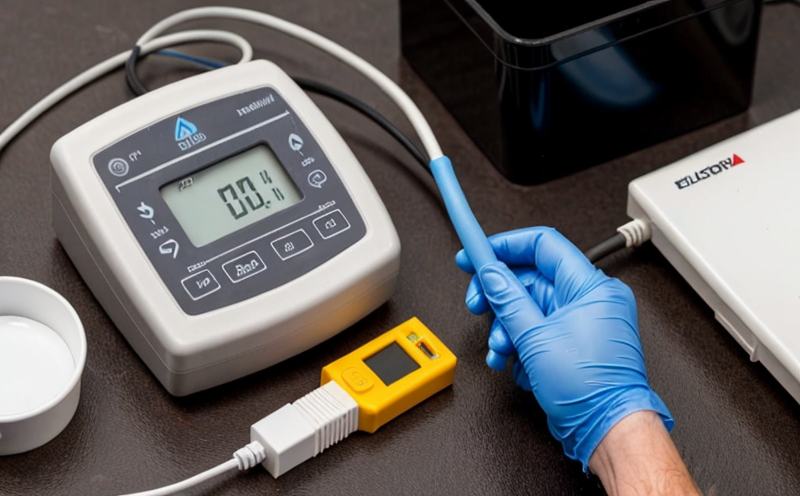DIN EN 13509 Electrochemical Cathodic Protection Testing
The DIN EN 13509 standard is an essential tool in ensuring reliable and effective cathodic protection systems. This method evaluates the performance of protective coatings on metallic structures to prevent corrosion. It focuses specifically on the polarization behavior of the protected metal surface, which indicates how well it resists corrosion. The test is particularly critical for infrastructure such as pipelines, storage tanks, and offshore platforms.
The standard outlines a procedure that involves immersing specimens in a controlled electrolyte solution under standardized conditions to simulate real-world environments. This immersion allows for the measurement of current density and polarization resistance, both of which are key indicators of the cathodic protection system's efficiency. The test is not just theoretical; it has practical implications for quality managers and compliance officers who need to ensure that their facilities meet regulatory standards.
The methodology involves detailed specimen preparation, including ensuring the surface area-to-volume ratio is appropriate for accurate measurement. Once prepared, specimens are immersed in a solution containing a known concentration of chloride ions, simulating soil or water conditions. The test apparatus includes a potentiostat and reference electrodes to measure the current flow accurately.
The acceptance criteria specify that the polarization resistance should be within certain limits, which vary based on the type of metal and its application. This ensures that the cathodic protection system is effective enough to protect the structure against corrosion. The results are reported in a detailed technical report, including data from all measurements taken during the test.
The DIN EN 13509 method is widely used across various sectors, particularly in industries like oil and gas, where the integrity of pipelines is critical for operational safety and environmental protection. It plays a vital role in quality assurance and compliance, ensuring that cathodic protection systems are not only effective but also environmentally sound.
For R&D engineers, this test provides insights into improving existing coatings or developing new ones. In procurement, it ensures that the materials used meet stringent performance standards, thus reducing the risk of costly failures down the line. Understanding and adhering to this standard is crucial for any organization dealing with long-term infrastructure projects.
The DIN EN 13509 test is not just a compliance requirement; it's an investment in maintaining critical infrastructure. By ensuring that cathodic protection systems are effective, organizations can save on maintenance costs and avoid the potential hazards of corrosion damage.
Scope and Methodology
| Test Step | Description |
|---|---|
| Specimen Preparation | The metal specimens are cleaned, degreased, and conditioned to ensure accurate measurement. |
| Immersion in Solution | Samples are immersed in a chloride ion solution under controlled conditions. |
| Potentiostat Application | A potentiostat is used to apply and measure current density and polarization resistance. |
| Data Collection | Measurements of current flow are recorded at regular intervals for analysis. |
| Acceptance Criteria | The results must meet specified limits defined in the standard. |
| Test Equipment | Description |
|---|---|
| Potentiostat | An instrument used to control and measure the potential of a galvanic cell. |
| Reference Electrodes | Electrodes that provide a stable reference point for measuring polarization. |
| Solution | A chloride ion solution simulates real-world environments like soil or water. |
| Data Acquisition System | A system to collect and analyze the data obtained during the test. |
Benefits
The DIN EN 13509 Electrochemical Cathodic Protection Testing offers numerous benefits, particularly for organizations involved in long-term infrastructure projects. By ensuring that cathodic protection systems are effective, it helps in:
Reducing maintenance costs by extending the life of metal structures.
Avoiding environmental hazards associated with corrosion damage.
Maintaining compliance with international standards and regulations.
Improving operational safety, especially in critical infrastructure like pipelines and storage tanks.
The test also provides valuable data for R&D engineers to enhance the performance of protective coatings. For quality managers and procurement officers, it ensures that only high-quality materials are used, reducing the risk of failures.
In essence, DIN EN 13509 is a cornerstone in ensuring the longevity and safety of metal structures. It helps organizations make informed decisions about their infrastructure maintenance strategies, ultimately contributing to a more sustainable future.
Why Choose This Test
Selecting DIN EN 13509 Electrochemical Cathodic Protection Testing is essential for several reasons:
The test provides accurate and reliable data on the polarization behavior of metal surfaces.
It ensures compliance with international standards, which is crucial for regulatory approval.
The test results are widely accepted in the industry, enhancing credibility and trust.
It offers a standardized method that can be consistently applied across different facilities and regions.
In addition to these benefits, the test is cost-effective in the long run by minimizing maintenance costs and preventing costly failures. It also supports sustainability goals by ensuring that infrastructure remains effective over its entire lifecycle.
The expertise of our laboratory ensures that each test is conducted rigorously and consistently. Our experienced team uses state-of-the-art equipment to provide accurate results, which are crucial for making informed decisions about the integrity of your facilities.





